by Randall Moles, DDS, MS
The key to practice growth in today’s economy
 |
It’s no secret that we are in difficult economic times. The production of many orthodontic practices is either flat or down. Maintaining your practice’s health under these circumstances requires a focused effort to bring in new patients and convert those patients to starts. My experience is that becoming a “virtual orthodontic practice” supplies the additional leverage needed to attract patients. For the past 4 years, our office has been a 100% “virtual practice,” which has proven to be a successful strategy. Despite economic downturns in our area, our starts have increased annually.
By “virtual orthodontic practice,” I mean that we are more than paperless. We treat all full cases in the virtual world using SureSmile or Invisalign technology. We don’t spend valuable practice and patient time bending wires or repositioning brackets. All of those functions are computerized, as is our treatment planning and most of our record-taking. We use scanning technology and the i-Cat to enter volumetric data and relational data to give us the ability to engage in what I call “virtual communication.” I believe “virtual communication” is an important key to success in the changed orthodontic market around us.
 |
| Randall Moles, DDS, MS |
Virtual Communication
Let’s first discuss communication in general, and then the concept of “virtual communication” in the orthodontic field. First of all, communication is the foundation of all human endeavors. It is the means by which we succeed or fail in this world. However, most of us take much of our communication for granted. We often give little thought to the impact or effectiveness of our communication. That is not to say that we don’t think about it. However, the key words here are “impact” and “effectiveness.” We don’t routinely think about how well our communication measures up in these two critical areas.
“Impact” describes how the message is perceived by the recipient. A quick way of saying this is, “Does it grab them?” Communication with impact always gets attention. It is much more likely to be heard above the din of messaging that constantly bombards us. “Effectiveness” deals with the content of the message. Is it clear, succinct, and informative? Another way of saying this is, “Do they really get what I want them to get?”
Unfortunately, to some degree orthodontics has become a commodity in the eyes of the public. Consumers see orthodontic treatment as similar, no matter who provides it or how it is provided. When a product is perceived as a commodity, then the only differentiating factor becomes the price. And in difficult economic times, price is even more important. I am not suggesting that you lower your prices. However, you need to understand that to be successful in today’s orthodontic environment, each practice has to differentiate itself in the marketplace. That differentiation needs to be strong enough that the patient is compelled to seek that particular office out of many. And, when the patient arrives at the office, the differentiation needs to be so compelling that the patient finds real value in starting treatment. The virtual orthodontic practice, with its inherent asset of virtual communication, excels at both of these goals.
 |
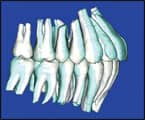 |
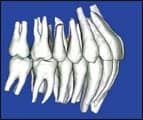 |
| Figure 1 | Figure 2 | Figure 3 |
The advantages provided by virtual communication go well beyond patient interaction. The virtual world provides the opportunity to disseminate information to referring doctors, other practitioners, and the community in general cheaply and efficiently. Let’s take a look at the impact of virtual communication in all areas, starting with you, the orthodontist.
Communication to Yourself
Communication can be among individuals or it can be to oneself. Let’s examine this idea. What do the patient’s records say to you? How much information do you get? What is the impact and the effectiveness of that communication?
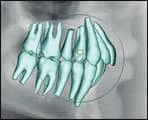 |
 |
| Figure 4 | Figure 5 |
Once you have diagnosed and treatment-planned a patient in the 3D virtual world, old methods pale in comparison. The impact and effectiveness of 3D communication is astounding. You now have the ability to see and move teeth with roots in the virtual world to forecast what you will do clinically for the actual patient. The ability to save that treatment plan and then “reset” with one click to try a different one is really a treat (Figures 1 to 3). Couple this with the ability to overlay these proposed movements on the radiograph, and you have a 3D VTO (Figures 4 to 5). Add to that the ability to transfer those tooth positions to the mouth with extreme accuracy, and now you have a diagnostic and therapeutic dream come true. The robotics of SureSmile allow the execution of even the most complicated treatment plans with complete fidelity.
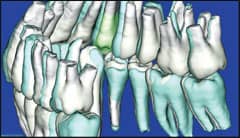 |
| Figure 6 |
Furthermore, in the virtual orthodontic practice the communication to the orthodontist does not diminish during treatment. A continuous feedback loop is established that enhances both the treatment and the orthodontist. With conventional orthodontic treatment, you are continually treating the patient in a reactive mode. You look in the mouth and see what has happened since the last visit. A decision on what to do next is based on what you see, and thus it is a reaction. In many ways it’s like driving a car by only looking in the rearview mirror!
This type of reactive communication is often inaccurate or incomplete. It is inaccurate because you have no idea if the wire has worked completely out. Moreover, you have no idea exactly what was bent into the wire at the last appointment, so inaccuracy is inherent in “the communication.” In addition, your view of the patient is incomplete since much of what is happening is impossible to see due to the patient’s anatomy. For example, you cannot see the occlusion from the lingual perspective. The communication in traditional orthodontics can hardly be called impactful or truly effective.
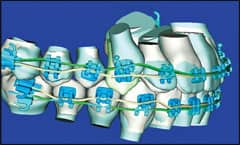 |
| Figure 7 |
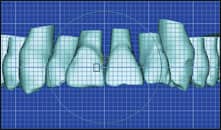 |
| Figure 8 |
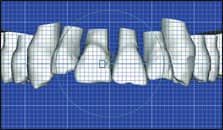 |
| Figure 9 |
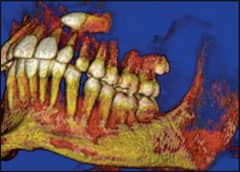 |
| Figure 10 |
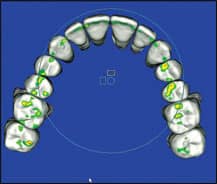 |
| Figure 11 |
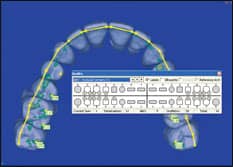 |
| Figure 12 |
In contrast, the virtual orthodontist has the ability to see how the teeth are going to move beforehand, (Figure 6) including desired movements, transition points, and final positions. This puts you in the position of being “proactive” instead of “reactive.” You can plan the application of forces with elastics and auxiliaries to augment the planned movements. That is one of the reasons that treatment using SureSmile is averaging 40% to 50% faster than conventional treatment in my office. The communication is both accurate and complete. I can see exactly what went into the wire and if it has worked out, (Figure 7) and I can see everything from any angle in the virtual word. From the beginning to the end of treatment, the communication has impact and is effective.
Doctor-to-Doctor Communication
Of course, you can be the best at anything, but if no one else knows it, you probably are going to have a tough go at being successful. The beauty of the virtual world is that it naturally spotlights excellence. The ability to try out treatment plans and then e-mail them back and forth with the family dentist is very impactful and effective. Asking the restorative dentist if this is the position desired for a tooth that he or she is going to restore strongly communicates a commitment to excellence (Figures 8 to 9). Reliably moving teeth to planned positions in half the time is a continual confirmation of that excellence. The ability to remotely work as a team with another practitioner and then follow up with the outcome is the essence of virtual communication.
The introduction of 3D CAT scanning offers even more opportunity for virtual communication. Evaluation of tooth positions—especially, impacted teeth or planning orthognathic procedures with the patient and the oral surgeon—is now even more impactful and effective (Figure 10). The opportunity to interface in real time via the Internet—with patients and all of those involved in their treatment using 3D data—is powerful indeed.
Communication to the Patient
The advantage of being a virtual practice begins when the patient first calls our office. After gathering the required information, we direct patients to our Web site for information and links on all of the services we provide. They are also encouraged to view our patient testimonial video available on the Web site, which is an important step in the process of motivating a patient to pursue treatment with our office.
When the patient arrives, we immediately take digital radiographs and photos to view on the computer screen at the chair for the examination. While the patient is waiting for these records to upload, they can view a video on SureSmile, Invisalign, and/or our patient testimonial if they have not seen it.
By providing as much information as possible in a timely and convenient manner, we are giving the patient the gift of being able to make a much more informed decision about their future treatment. During our one-step exam/consultation we are able to present visuals on the computer screen to illustrate and enhance our presentation.
The process continues throughout treatment. From our online newsletter to e-mail appointment reminders, patients are constantly reminded of our technological excellence and our commitment to making their experience easier. During the process of diagnosis and treatment, it is very easy to grab a screen shot of the targeted tooth positions and send it to the patient. For patients, being able to see their teeth with roots (a function of the i-Cat combined with SureSmile), then how they will move to the final position, certainly has impact. For them to see the contact points on these teeth and to see how we have ABO scored their “setup” is truly the essence of effective communication (Figure 11).
Communication to the Community
Of course, neither our practice nor our patients exist in a vacuum.
Virtual communication also makes it easy to disseminate information about our practice to the community around us. Patients can easily share the visuals of their treatment with their families and friends. The virtual medium makes it easy to “pass it on.”
The key ingredient inherent in our virtual practice is the ability to document results, such as treatment time and finish, as opposed to just “guesstimating.” With a few clicks, we can accurately track any number of patient parameters, from treatment time to minutes in the chair or minutes waiting. Using SureSmile, we can generate a Board Score that tells both us, the patient, and the referring dentist how well we have done in achieving our goals (Figure 12). Again, it is easy to “pass it on.” The old saying that “word travels fast” is applicable here, but with virtual communication we can give that concept a huge boost.
A Final Word
|
For complete information on the |
Of course, creating the virtual practice is not cheap; but I believe that the “cost” of complacency is always more expensive. The world of orthodontics has changed and will continue to change. More competition from outside the profession, more savvy consumers, and a more difficult economic environment will weigh heavier and heavier on the practice that cannot provide, prove, and communicate its excellence. The virtual practice will succeed in any economic environment.
Randall Moles, DDS, MS, is in private practice in Racine, Wash. He served in the US Coast Guard Division of the United States Public Health Service and as an associate professor of Orthodontics at Marquette. He is certified by the American Board of Orthodontics and The American Academy of Pain Management. He has written a book and numerous articles, and also lectures on aspects of accelerated orthodontics, TMD, and practice management. He can be reached at









